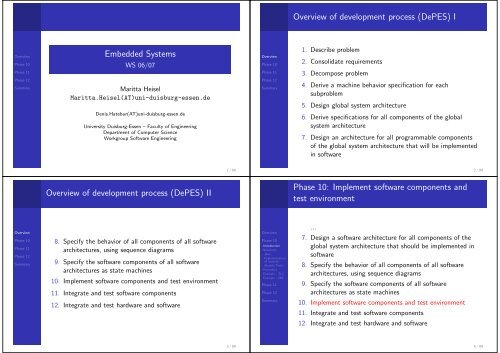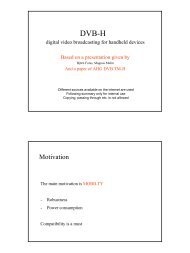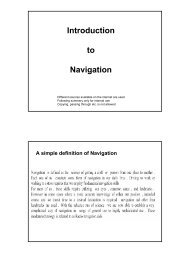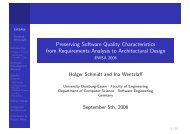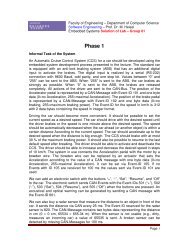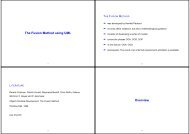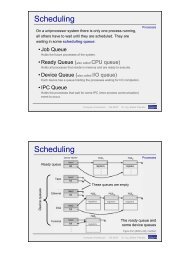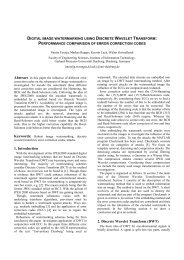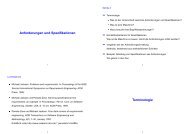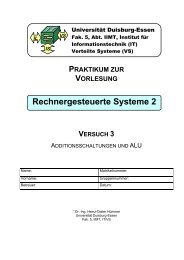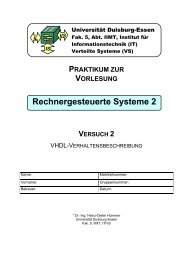(4 slides per page) - Updated
(4 slides per page) - Updated
(4 slides per page) - Updated
Create successful ePaper yourself
Turn your PDF publications into a flip-book with our unique Google optimized e-Paper software.
Overview<br />
Phase 10<br />
Phase 11<br />
Phase 12<br />
Summary<br />
Overview<br />
Phase 10<br />
Phase 11<br />
Phase 12<br />
Summary<br />
Embedded Systems<br />
WS 06/07<br />
Maritta Heisel<br />
Maritta.Heisel(AT)uni-duisburg-essen.de<br />
Denis.Hatebur(AT)uni-duisburg-essen.de<br />
University Duisburg-Essen – Faculty of Engineering<br />
Department of Computer Science<br />
Workgroup Software Engineering<br />
Overview of development process (DePES) II<br />
8. Specify the behavior of all components of all software<br />
architectures, using sequence diagrams<br />
9. Specify the software components of all software<br />
architectures as state machines<br />
10. Implement software components and test environment<br />
11. Integrate and test software components<br />
12. Integrate and test hardware and software<br />
1/89<br />
3/89<br />
Overview<br />
Phase 10<br />
Phase 11<br />
Phase 12<br />
Summary<br />
Overview<br />
Phase 10<br />
Introduction<br />
Notations<br />
Java<br />
Implementation<br />
of modules<br />
Module Tests<br />
Procedure<br />
Example - TLC<br />
Example - SBC<br />
Phase 11<br />
Phase 12<br />
Summary<br />
Overview of development process (DePES) I<br />
1. Describe problem<br />
2. Consolidate requirements<br />
3. Decompose problem<br />
4. Derive a machine behavior specification for each<br />
subproblem<br />
5. Design global system architecture<br />
6. Derive specifications for all components of the global<br />
system architecture<br />
7. Design an architecture for all programmable components<br />
of the global system architecture that will be implemented<br />
in software<br />
Phase 10: Implement software components and<br />
test environment<br />
...<br />
7. Design a software architecture for all components of the<br />
global system architecture that should be implemented in<br />
software<br />
8. Specify the behavior of all components of all software<br />
architectures, using sequence diagrams<br />
9. Specify the software components of all software<br />
architectures as state machines<br />
10. Implement software components and test environment<br />
11. Integrate and test software components<br />
12. Integrate and test hardware and software<br />
2/89<br />
4/89
Overview<br />
Phase 10<br />
Introduction<br />
Notations<br />
Java<br />
Implementation<br />
of modules<br />
Module Tests<br />
Procedure<br />
Example - TLC<br />
Example - SBC<br />
Phase 11<br />
Phase 12<br />
Summary<br />
Overview<br />
Phase 10<br />
Introduction<br />
Notations<br />
Java<br />
Implementation<br />
of modules<br />
Module Tests<br />
Procedure<br />
Example - TLC<br />
Example - SBC<br />
Phase 11<br />
Phase 12<br />
Summary<br />
Phase 10: Implement software components and<br />
test environment<br />
input:<br />
specification<br />
Phase 9<br />
of merged components of<br />
different notations<br />
software component behavior from Phase 8 sequence diagrams<br />
output: implemented software components programming language<br />
test software for software components<br />
programming language<br />
or test language<br />
validation: run tests test results<br />
Constants<br />
in C++:<br />
#define X 2<br />
or const int X = 2;<br />
in Java: final static int X = 2;<br />
5/89<br />
7/89<br />
Overview<br />
Phase 10<br />
Introduction<br />
Notations<br />
Java<br />
Implementation<br />
of modules<br />
Module Tests<br />
Procedure<br />
Example - TLC<br />
Example - SBC<br />
Phase 11<br />
Phase 12<br />
Summary<br />
Overview<br />
Phase 10<br />
Introduction<br />
Notations<br />
Java<br />
Implementation<br />
of modules<br />
Module Tests<br />
Procedure<br />
Example - TLC<br />
Example - SBC<br />
Phase 11<br />
Phase 12<br />
Summary<br />
Notations and concepts<br />
Java<br />
Implementation of modules<br />
Module tests<br />
ClassesinJava<br />
always one file for one class, no header files<br />
name of constructor = name of class = name of file<br />
There is no destructor, the garbage collection frees<br />
memory of unused objects (e.g. for objects set to null).<br />
The entry point of an application is<br />
public static void main (String[] args)<br />
in one class (file).<br />
6/89<br />
8/89
Overview<br />
Phase 10<br />
Introduction<br />
Notations<br />
Java<br />
Implementation<br />
of modules<br />
Module Tests<br />
Procedure<br />
Example - TLC<br />
Example - SBC<br />
Phase 11<br />
Phase 12<br />
Summary<br />
Overview<br />
Phase 10<br />
Introduction<br />
Notations<br />
Java<br />
Implementation<br />
of modules<br />
Module Tests<br />
Procedure<br />
Example - TLC<br />
Example - SBC<br />
Phase 11<br />
Phase 12<br />
Summary<br />
Objects in Java<br />
All objects that are not simple data types such as<br />
boolean, char, byte, short, int, long, float,<br />
double have to be created explicitly.<br />
For some simple data types predefined classes exist (e.g.<br />
Integer for int). These classes provide methods like,<br />
e.g., toString.<br />
Create an object m of the class Integer:<br />
Integer m = new Integer();<br />
Or: Integer m; m = new Integer();<br />
Attributes and methods declared as static belong to the<br />
class and are the same for all objects.<br />
su<strong>per</strong> can be used to access functionality of the the<br />
su<strong>per</strong>class.<br />
this can be used to reference the object itself.<br />
Abstract Classes<br />
Methods that are not yet implemented can be defined as<br />
abstract.<br />
A class with at least one abstract method is an abstract<br />
class.<br />
Abstract classes are useful for inheritance.<br />
Java supports no multiple inheritance.<br />
An abstract class has to be extended by another class<br />
where the method has to be implemented (keyword:<br />
extends).<br />
It is not possible to create objects of an abstract class.<br />
9/89<br />
11 / 89<br />
Overview<br />
Phase 10<br />
Introduction<br />
Notations<br />
Java<br />
Implementation<br />
of modules<br />
Module Tests<br />
Procedure<br />
Example - TLC<br />
Example - SBC<br />
Phase 11<br />
Phase 12<br />
Summary<br />
Overview<br />
Phase 10<br />
Introduction<br />
Notations<br />
Java<br />
Implementation<br />
of modules<br />
Module Tests<br />
Procedure<br />
Example - TLC<br />
Example - SBC<br />
Phase 11<br />
Phase 12<br />
Summary<br />
Classes: Example<br />
public class MainInit {<br />
private Integer i; // Attributes<br />
private String s;<br />
}<br />
public MainInit() { // Constructor<br />
s = new String();<br />
i = new Integer(7);<br />
}<br />
public static void main(String [] args) {<br />
MainInit m = new MainInit();<br />
}<br />
Abstract Classes: Example<br />
<br />
animal<br />
abstract makesound()<br />
<br />
dog<br />
cat<br />
makesound() makesound()<br />
10 / 89<br />
public abstract class Animal {<br />
public Animal(){}<br />
public abstract void makeSound();<br />
}<br />
public class Cat extends Animal {<br />
public Cat(){}<br />
public void makeSound()<br />
{System.out.println("miaow");}<br />
}<br />
public class Dog extends Animal {<br />
public Dog(){}<br />
public void makeSound()<br />
{System.out.println("woof-woof");}<br />
}<br />
public class Main{<br />
public static void main(String[] args) {<br />
Animal a1 = new Dog();<br />
Animal a2 = new Cat();<br />
a1.makeSound(); a2.makeSound();<br />
}<br />
}<br />
12 / 89
Overview<br />
Phase 10<br />
Introduction<br />
Notations<br />
Java<br />
Implementation<br />
of modules<br />
Module Tests<br />
Procedure<br />
Example - TLC<br />
Example - SBC<br />
Phase 11<br />
Phase 12<br />
Summary<br />
Overview<br />
Phase 10<br />
Introduction<br />
Notations<br />
Java<br />
Implementation<br />
of modules<br />
Module Tests<br />
Procedure<br />
Example - TLC<br />
Example - SBC<br />
Phase 11<br />
Phase 12<br />
Summary<br />
Interface Classes<br />
A class where all methods are abstract can be declared as<br />
an interface.<br />
A class can implement several interfaces (keyword<br />
implements), but it can only extend one other class.<br />
A class can be accessed using the interface.<br />
An interface class has no constructor.<br />
Solves problem of multiple inheritance.<br />
Exceptions<br />
Methods can throw exceptions<br />
public int div(int n1, int n2) throws Exception {<br />
if (n2==0) throw Exception;<br />
...<br />
}<br />
Exceptions can be handled with try and catch<br />
try {<br />
a = div(b,c);<br />
} catch (Exception e) {<br />
System.out.println(e);<br />
}<br />
Other exceptions are e.g. IOException,<br />
ClassNotFoundException, ArithmeticException,<br />
OutOfMemoryError, Error.<br />
13 / 89<br />
15 / 89<br />
Overview<br />
Phase 10<br />
Introduction<br />
Notations<br />
Java<br />
Implementation<br />
of modules<br />
Module Tests<br />
Procedure<br />
Example - TLC<br />
Example - SBC<br />
Phase 11<br />
Phase 12<br />
Summary<br />
Overview<br />
Phase 10<br />
Introduction<br />
Notations<br />
Java<br />
Implementation<br />
of modules<br />
Module Tests<br />
Procedure<br />
Example - TLC<br />
Example - SBC<br />
Phase 11<br />
Phase 12<br />
Summary<br />
Interface Classes: Example<br />
<br />
animal<br />
abstract makesound()<br />
<br />
dog<br />
cat<br />
makesound() makesound()<br />
Assertions<br />
public interface Animal {<br />
public void makeSound();<br />
}<br />
public class Cat implements Animal {<br />
public Cat(){}<br />
public void makeSound()<br />
{System.out.println("miaow");}<br />
}<br />
public class Dog implements Animal {<br />
public Dog(){}<br />
public void makeSound()<br />
{System.out.println("woof-woof");}<br />
}<br />
public class Main{<br />
public static void main(String[] args) {<br />
Animal a1 = new Dog();<br />
Animal a2 = new Cat();<br />
a1.makeSound(); a2.makeSound();<br />
}<br />
}<br />
14 / 89<br />
Assertions can be used to specify (and check) the<br />
pre-conditions of a method.<br />
Assertions are defined using<br />
assert condition==true: "ErrorString";<br />
Assertions are introduced in Java 1.5, they are only<br />
evaluated using the execution switch “evaluate assertions”:<br />
java -ea<br />
Exceptions thrown by assertions cannot be caught.<br />
16 / 89
Overview<br />
Phase 10<br />
Introduction<br />
Notations<br />
Java<br />
Implementation<br />
of modules<br />
Module Tests<br />
Procedure<br />
Example - TLC<br />
Example - SBC<br />
Phase 11<br />
Phase 12<br />
Summary<br />
Overview<br />
Phase 10<br />
Introduction<br />
Notations<br />
Java<br />
Implementation<br />
of modules<br />
Module Tests<br />
Procedure<br />
Example - TLC<br />
Example - SBC<br />
Phase 11<br />
Phase 12<br />
Summary<br />
Threads<br />
Threads are necessary for active components.<br />
Systems with one processor use time slices to simulate<br />
parallelism for several threads.<br />
The started thread runs “in parallel” to the other parts of<br />
the software.<br />
Threads in Java support the following functionality:<br />
start starts the Thread<br />
interrupt stops the thread<br />
setName Assigns a name to the thread.<br />
sleep Waits the time given as a parameter in ms.<br />
yield Advises the scheduler to run another thread at this time.<br />
setPriority Assigns a priority to the thread. Threads with a higher<br />
priority get more execution time or they preempt the<br />
other tasks (depends on OS).<br />
Example: Threads with Runnable interface<br />
(alternative way)<br />
17 / 89<br />
import java.lang.*;<br />
public class Clock implements Runnable{<br />
private Thread clockThread; // Attributes<br />
private ms_clock clk;<br />
public Clock(ms_clock call) { // Constructor<br />
clk = call;<br />
clockThread = new Thread (this);// an object of type Thread<br />
clockThread.start(); // must be created with the<br />
} // object of Clock as a param.<br />
public void run () { // Thread<br />
while (true) { // endless Loop<br />
clk.MsClock();<br />
try {<br />
Thread.sleep(1);<br />
} catch ( Exception e ) {<br />
System.out.println( e );<br />
}<br />
}<br />
}<br />
}<br />
Must be used if the class extends another class.<br />
19 / 89<br />
Overview<br />
Phase 10<br />
Introduction<br />
Notations<br />
Java<br />
Implementation<br />
of modules<br />
Module Tests<br />
Procedure<br />
Example - TLC<br />
Example - SBC<br />
Phase 11<br />
Phase 12<br />
Summary<br />
Overview<br />
Phase 10<br />
Introduction<br />
Notations<br />
Java<br />
Implementation<br />
of modules<br />
Module Tests<br />
Procedure<br />
Example - TLC<br />
Example - SBC<br />
Phase 11<br />
Phase 12<br />
Summary<br />
Example: Threads<br />
import java.lang.*;<br />
public class Clock extends Thread{<br />
private ms_clock clk; // Attributes<br />
public Clock(ms_clock call) { // Constructor<br />
clk = call;<br />
this.start();<br />
}<br />
public void run () { // Thread<br />
while (true) { // endless Loop<br />
clk.MsClock();<br />
try {<br />
Thread.sleep(1); //this.sleep(1) is also possible<br />
} catch ( Exception e ) {<br />
System.out.println( e );<br />
}<br />
}<br />
}<br />
}<br />
Problem: Concurrent access to Variables<br />
time<br />
Thread 1 Thread 2<br />
setVal(...)<br />
x[0] = a<br />
x[1] = b<br />
x[2] = c<br />
setVal(...)<br />
x[0] = a<br />
x[1] = b<br />
x[2] = c<br />
getSum()<br />
a = x[0];<br />
b = x[1];<br />
c = x[2];<br />
getSum()<br />
a = x[0];<br />
b = x[1];<br />
c = x[2];<br />
wrong Value<br />
getSum() is executed<br />
before the array is<br />
filled completely.<br />
18 / 89<br />
20 / 89
Overview<br />
Phase 10<br />
Introduction<br />
Notations<br />
Java<br />
Implementation<br />
of modules<br />
Module Tests<br />
Procedure<br />
Example - TLC<br />
Example - SBC<br />
Phase 11<br />
Phase 12<br />
Summary<br />
Overview<br />
Phase 10<br />
Introduction<br />
Notations<br />
Java<br />
Implementation<br />
of modules<br />
Module Tests<br />
Procedure<br />
Example - TLC<br />
Example - SBC<br />
Phase 11<br />
Phase 12<br />
Summary<br />
Solution: Synchronize<br />
public class SharedMemSum {<br />
private int[] x;<br />
public SharedMemSum () {<br />
x = new int [3] ;<br />
x[0]=0; x[1]=0; x[2]=0;<br />
}<br />
synchronized int getSum() {<br />
int a,b,c;<br />
a=x[0]; b=x[1]; c=x[2];<br />
return a+b+c;<br />
}<br />
synchronized void setVal(int a, int b, int c) {<br />
x[0] = a; x[1] = b; x[1] = c;<br />
}<br />
}<br />
The statement synchronized makes a method<br />
non-interruptable.<br />
Implementation of modules / software components<br />
II<br />
Interfaces can be implemented using<br />
directly called methods,<br />
methods in interface classes, or<br />
messages, e.g.<br />
delegates in C♯,<br />
events in Java,<br />
signals and slots in C++ with the Qt-library,<br />
messages in the Windows API.<br />
Messages usually allow asynchronous communication (with<br />
queuing) and in some frameworks multiple consumers are<br />
allowed.<br />
21 / 89<br />
23 / 89<br />
Overview<br />
Phase 10<br />
Introduction<br />
Notations<br />
Java<br />
Implementation<br />
of modules<br />
Module Tests<br />
Procedure<br />
Example - TLC<br />
Example - SBC<br />
Phase 11<br />
Phase 12<br />
Summary<br />
Overview<br />
Phase 10<br />
Introduction<br />
Notations<br />
Java<br />
Implementation<br />
of modules<br />
Module Tests<br />
Procedure<br />
Example - TLC<br />
Example - SBC<br />
Phase 11<br />
Phase 12<br />
Summary<br />
Implementation of modules / software components<br />
I<br />
Amodulehasprovidedandrequiredinterfacesthatcanbe<br />
connected with other modules<br />
A module only uses functionality from the provided<br />
interfaces, from the programming language, and a limited<br />
set of o<strong>per</strong>ations of the o<strong>per</strong>ating system (e.g., tasks,<br />
threads, memory allocation, timers, messages,<br />
synchronization mechanisms).<br />
Active components are implemented using threads.<br />
Implementation of interfaces I<br />
Loose and tight coupling is possible for interfaces between<br />
components.<br />
Tight (directly called methods) coupling is used if<br />
methods of a class and not of an object are called.<br />
Tight coupling of objects can only be implemented if the<br />
called object is created by the calling class.<br />
For loose coupling (methods in interface classes) the<br />
objects are created by a different class. The object that<br />
uses an interface of another object needs a reference to<br />
the used object. The reference can be provided in the<br />
constructororinanadditionalmethodtoconnectthe<br />
objects.<br />
22 / 89<br />
24 / 89
Overview<br />
Phase 10<br />
Introduction<br />
Notations<br />
Java<br />
Implementation<br />
of modules<br />
Module Tests<br />
Procedure<br />
Example - TLC<br />
Example - SBC<br />
Phase 11<br />
Phase 12<br />
Summary<br />
Overview<br />
Phase 10<br />
Introduction<br />
Notations<br />
Java<br />
Implementation<br />
of modules<br />
Module Tests<br />
Procedure<br />
Example - TLC<br />
Example - SBC<br />
Phase 11<br />
Phase 12<br />
Summary<br />
Implementation of interfaces II<br />
Tight coupling usually need less resources and can also be<br />
implemented using non-oo languages.<br />
With loose coupling, the object can be implemented<br />
independently of its environment. The object becomes a<br />
component. Messages implement a loose coupling. Loose<br />
coupling is better for the implementation of module tests.<br />
Implementation of provided interfaces in Java<br />
Each provided interface is defined as a interface class, e.g.:<br />
public interface LineIn {<br />
public void transmitMusic();<br />
}<br />
public interface PowerSupply {<br />
public void powerOn();<br />
}<br />
A component can implement / provide several interfaces, e.g.:<br />
25 / 89<br />
public class AmplifierAndSpeeker implements LineIn, PowerSupply<br />
public AmplifierAndSpeeker (){} //constructor<br />
public void transmitMusic() { Play;}<br />
public void powerOn() { Action2;}<br />
}<br />
All provided o<strong>per</strong>ations must be implemented as methods.<br />
27 / 89<br />
Overview<br />
Phase 10<br />
Introduction<br />
Notations<br />
Java<br />
Implementation<br />
of modules<br />
Module Tests<br />
Procedure<br />
Example - TLC<br />
Example - SBC<br />
Phase 11<br />
Phase 12<br />
Summary<br />
Overview<br />
Phase 10<br />
Introduction<br />
Notations<br />
Java<br />
Implementation<br />
of modules<br />
Module Tests<br />
Procedure<br />
Example - TLC<br />
Example - SBC<br />
Phase 11<br />
Phase 12<br />
Summary<br />
Implementation of interfaces in Java<br />
≪ interface ≫<br />
if name<br />
method 1 (par1: Integer)<br />
method 2():String<br />
package project_name;<br />
public interface if_name {<br />
public void method_1 (int par1);<br />
public String method_2 ();<br />
}<br />
The project name should be added as a package. Otherwise<br />
additional parameters are necessary to compile the project.<br />
Note: int is a simple data type and and String is a class.<br />
Implementation of used interfaces in Java I<br />
A component can use / require several interfaces, defined as<br />
interface classes.<br />
public class Tuner implements PowerSupply {<br />
private LineIn outputDevice;<br />
public Tuner(){ outputDevice = NULL; }<br />
public void connectTo(LineIn par) {outputDevice = par;}<br />
}<br />
public void powerOn() {<br />
while (true) {<br />
if (outputDevice!=NULL) outputDevice.transmitMusic();<br />
}<br />
26 / 89<br />
28 / 89
Overview<br />
Phase 10<br />
Introduction<br />
Notations<br />
Java<br />
Implementation<br />
of modules<br />
Module Tests<br />
Procedure<br />
Example - TLC<br />
Example - SBC<br />
Phase 11<br />
Phase 12<br />
Summary<br />
Overview<br />
Phase 10<br />
Introduction<br />
Notations<br />
Java<br />
Implementation<br />
of modules<br />
Module Tests<br />
Procedure<br />
Example - TLC<br />
Example - SBC<br />
Phase 11<br />
Phase 12<br />
Summary<br />
Implementation of used interfaces in Java II<br />
The required interfaces become private attributes<br />
(outputDevive of type LineIn).<br />
The component has to provide a method to connect the<br />
component to the required component (connectTo). In<br />
this connect method, the private attributes is initialized.<br />
Using this private attribute, the connected component can<br />
be used. It should only be used if it is initialized (if<br />
(outputDevice!=NULL) ... ).<br />
Alternatively, it is possible to leave out the method connectTo<br />
and initialize the connected interface in the constructor.<br />
The component Tuner also provides the interface<br />
PowerSupply and implements the method powerOn.<br />
Implementation of used interfaces in Java IV<br />
The components bat1, bat2, myTuner, and myAmp can be<br />
connected as follows:<br />
Tuner<br />
bat1: Battery<br />
PowerSupply<br />
Amplifier<br />
AndSpeeker<br />
bat2: Battery<br />
AmplifierAndSpeeker myAmp = new AmplifierAndSpeeker();<br />
Tuner myTuner = new Tuner();<br />
Battery bat1 = new Battery();<br />
Battery bat2 = new Battery()<br />
myTumer.connectTo(myAmp);<br />
bat1.connectTo(myTuner);<br />
bat2.connectTo(myAmp);<br />
29 / 89<br />
31 / 89<br />
Overview<br />
Phase 10<br />
Introduction<br />
Notations<br />
Java<br />
Implementation<br />
of modules<br />
Module Tests<br />
Procedure<br />
Example - TLC<br />
Example - SBC<br />
Phase 11<br />
Phase 12<br />
Summary<br />
Overview<br />
Phase 10<br />
Introduction<br />
Notations<br />
Java<br />
Implementation<br />
of modules<br />
Module Tests<br />
Procedure<br />
Example - TLC<br />
Example - SBC<br />
Phase 11<br />
Phase 12<br />
Summary<br />
Implementation of used interfaces in Java III<br />
public class Battery {<br />
public Battery(){ }<br />
private PowerSupply suppliedDevice;<br />
public void connectTo(PowerSupply suppliedDevice ) {<br />
suppliedDevice.powerOn();<br />
}<br />
}<br />
The component Battery powers on the supplied device when<br />
connected. It requires the interface PowerSupply.<br />
Implementation of state machines in Java I<br />
Can be implemented in different ways; here just one alternative<br />
is shown.<br />
Define a constant for each state.<br />
Set the initial state in the constructor.<br />
Create a method for each incoming signal.<br />
Add a case distinction containing all possible states to this<br />
method.<br />
In each case emit the specified output signals and set the<br />
new state of the state machine.<br />
Add appropriate handling for the parameters of the signals.<br />
Add a default case.<br />
30 / 89<br />
32 / 89
Overview<br />
Phase 10<br />
Introduction<br />
Notations<br />
Java<br />
Implementation<br />
of modules<br />
Module Tests<br />
Procedure<br />
Example - TLC<br />
Example - SBC<br />
Phase 11<br />
[Id10] /<br />
Major (Id),<br />
MajorReq := Id<br />
Module Tests II<br />
public class ComponentName implements provided_if {<br />
static final int IDLE = 0, BUSY = 1;<br />
private req_if ri;<br />
private int state;<br />
...<br />
public ComponentName (req_if ri_) {<br />
state = ... // Init state<br />
ri = ri_;<br />
}<br />
public void Req(int id) {<br />
switch (state) {<br />
case IDLE:<br />
}<br />
} ...<br />
if (id
Overview<br />
Phase 10<br />
Introduction<br />
Notations<br />
Java<br />
Implementation<br />
of modules<br />
Module Tests<br />
Procedure<br />
Example - TLC<br />
Example - SBC<br />
Phase 11<br />
Phase 12<br />
Summary<br />
Overview<br />
Phase 10<br />
Introduction<br />
Notations<br />
Java<br />
Implementation<br />
of modules<br />
Module Tests<br />
Procedure<br />
Example - TLC<br />
Example - SBC<br />
Phase 11<br />
Phase 12<br />
Summary<br />
Executing Phase 10<br />
In general, the procedure to implement and test software<br />
components using an object oriented programming languages<br />
can be described as follows:<br />
1. Create interface classes for all internal interfaces (also for<br />
subcomponents).<br />
2. Create classes for all (sub-)components and implement<br />
them.<br />
Implement actions as private methods.<br />
Implement the state machine.<br />
Implement the active classes with threads.<br />
Check all classes if there is a concurrent access to complex<br />
variables and resolve this problem with the synchronized<br />
statement.<br />
3. Implement test cases for all components (except HAL)<br />
according to the sequence diagrams of Phase 8.<br />
4. Run test cases.<br />
Remarks II<br />
The software components are implemented using some<br />
simple heuristics. For embedded systems, usually a static<br />
connection between components is established. The<br />
connectors in the composite structure diagrams can be<br />
implemented e.g. as data streams, method calls,<br />
asynchronous messages, or hardware access.<br />
This development process allows developing statically<br />
linked software components with the capability of reuse.<br />
37 / 89<br />
39 / 89<br />
Overview<br />
Phase 10<br />
Introduction<br />
Notations<br />
Java<br />
Implementation<br />
of modules<br />
Module Tests<br />
Procedure<br />
Example - TLC<br />
Example - SBC<br />
Phase 11<br />
Phase 12<br />
Summary<br />
Overview<br />
Phase 10<br />
Introduction<br />
Notations<br />
Java<br />
Implementation<br />
of modules<br />
Module Tests<br />
Procedure<br />
Example - TLC<br />
Example - SBC<br />
Phase 11<br />
Phase 12<br />
Summary<br />
Remarks I<br />
Only the software components are implemented in this<br />
phase. They will be connected / integrated in the next<br />
phase.<br />
The validation of this phase is <strong>per</strong>formed by running the<br />
test cases.<br />
The HAL is difficult to test because the hardware is<br />
directly connected to the HAL. Therefore, manual tests<br />
using measurement equipment and debugging tools should<br />
be <strong>per</strong>formed.<br />
Real-time functionality must be tested in an emulator.<br />
Example 1: traffic light control<br />
38 / 89<br />
40 / 89
Overview<br />
Phase 10<br />
Introduction<br />
Notations<br />
Java<br />
Implementation<br />
of modules<br />
Module Tests<br />
Procedure<br />
Example - TLC<br />
Example - SBC<br />
Phase 11<br />
Phase 12<br />
Summary<br />
Overview<br />
Phase 10<br />
Introduction<br />
Notations<br />
Java<br />
Implementation<br />
of modules<br />
Module Tests<br />
Procedure<br />
Example - TLC<br />
Example - SBC<br />
Phase 11<br />
Phase 12<br />
Summary<br />
Create interface classes<br />
<br />
lights_state_if<br />
main_red ()<br />
sec_red ()<br />
main_yellow ()<br />
sec_yellow ()<br />
main_green ()<br />
sec_green ()<br />
main_yellow_red ()<br />
sec_yellow_red ()<br />
all_off ()<br />
Implement actions as private methods<br />
package tlc;<br />
public interface lights_state_if {<br />
public void main_red();<br />
public void sec_red();<br />
public void main_yellow();<br />
public void sec_yellow();<br />
public void main_red_yellow();<br />
public void sec_red_yellow();<br />
public void main_green();<br />
public void sec_green();<br />
public void all_off();<br />
}<br />
41 / 89<br />
package tlc;<br />
public class TimeOutTimer implements<br />
ms_clock, set_timeout {<br />
IsZero()<br />
...<br />
pre true<br />
post Result = true ⇔<br />
remaining time = 0<br />
private long remaining_time = 0;<br />
...<br />
private boolean IsZero() {<br />
return (remaining_time == 0);<br />
SetTime(x)<br />
}<br />
pre time ≥ 0<br />
private void SetTime(long time) {<br />
assert (time >= 0): "PRE: SetTime";<br />
post remaining time = x<br />
remaining_time = time;<br />
DecTime()<br />
}<br />
private void DecTime() {<br />
pre remaining time = 0<br />
assert remaining_time!=0:<br />
post remaining time =<br />
"PRE: DecTime";<br />
remaining time@pre −1 remaining_time = remaining_time - 1 ;<br />
}<br />
}<br />
43 / 89<br />
Overview<br />
Phase 10<br />
Introduction<br />
Notations<br />
Java<br />
Implementation<br />
of modules<br />
Module Tests<br />
Procedure<br />
Example - TLC<br />
Example - SBC<br />
Phase 11<br />
Phase 12<br />
Summary<br />
Overview<br />
Phase 10<br />
Introduction<br />
Notations<br />
Java<br />
Implementation<br />
of modules<br />
Module Tests<br />
Procedure<br />
Example - TLC<br />
Example - SBC<br />
Phase 11<br />
Phase 12<br />
Summary<br />
Create classes for all (sub-)components<br />
ms_clock<br />
C_TimeOutTimer<br />
−remainingTime: Long<br />
− SetTime (Time: Long)<br />
− IsZero (): Boolean<br />
− DecTime ()<br />
set_timeout<br />
timeout<br />
package tlc;<br />
public class TimeOutTimer implements<br />
ms_clock, set_timeout {<br />
private timeout to;<br />
private long remaining_time = 0;<br />
public TimeOutTimer(timeout timeout_par)<br />
{<br />
to = timeout_par;<br />
}<br />
public void SetTimeOut(int seconds) {}<br />
public void MsClock() {}<br />
private void SetTime(long time) {}<br />
private boolean IsZero() {}<br />
private void DecTime() {}<br />
}<br />
All methods of all provided interfaces have to be implemented<br />
(here: SetTimeOut, MsClock). An empty function body ({}) is<br />
used to avoid error messages of the compiler.<br />
Implement the state machine as public methods I<br />
TimeOutTimer<br />
/ SetTime(0)<br />
Stopped<br />
MsClock ()<br />
SetTimeOut (seconds)<br />
/ SetTime (seconds * 1000)<br />
[IsZero()] / TimeOut ()<br />
[ELSE]<br />
SetTimeOut (seconds)<br />
/ SetTime (seconds * 1000)<br />
Running<br />
MsClock () / DecTime()<br />
42 / 89<br />
44 / 89
Overview<br />
Phase 10<br />
Introduction<br />
Notations<br />
Java<br />
Implementation<br />
of modules<br />
Module Tests<br />
Procedure<br />
Example - TLC<br />
Example - SBC<br />
Phase 11<br />
Phase 12<br />
Summary<br />
Overview<br />
Phase 10<br />
Introduction<br />
Notations<br />
Java<br />
Implementation<br />
of modules<br />
Module Tests<br />
Procedure<br />
Example - TLC<br />
Example - SBC<br />
Phase 11<br />
Phase 12<br />
Summary<br />
Implement the state machine as public methods II<br />
package tlc;<br />
public class TimeOutTimer implements ms_clock, set_timeout {<br />
static final int STOPPED = 0;<br />
static final int RUNNING = 1;<br />
private int state;<br />
...<br />
public TimeOutTimer(timeout timeout_par) {<br />
...<br />
SetTime(0); state = STOPPED;<br />
}<br />
public void SetTimeOut(int seconds) {<br />
switch (state) {<br />
case STOPPED:<br />
SetTime(seconds*1000); state = RUNNING; break;<br />
case RUNNING:<br />
SetTime(seconds*1000); break;<br />
default:<br />
assert false: "FSM error TimeOutTimer.SetTimeOut";<br />
}<br />
} ...<br />
Do not forget the break-statement. Otherwise, the next case will also be<br />
executed.<br />
Implement the active classes with threads<br />
C_Clock<br />
ms_clock<br />
package tlc;<br />
import java.lang.*;<br />
public class Clock extends Thread{<br />
private ms_clock clk;<br />
public Clock(ms_clock call) {<br />
clk = call;<br />
this.start();<br />
}<br />
public void run () {<br />
while (true) {<br />
clk.MsClock();<br />
try {<br />
Thread.sleep(1);<br />
} catch ( Exception e ) {<br />
System.out.println( e );<br />
}<br />
}<br />
}<br />
}<br />
45 / 89<br />
47 / 89<br />
Overview<br />
Phase 10<br />
Introduction<br />
Notations<br />
Java<br />
Implementation<br />
of modules<br />
Module Tests<br />
Procedure<br />
Example - TLC<br />
Example - SBC<br />
Phase 11<br />
Phase 12<br />
Summary<br />
Overview<br />
Phase 10<br />
Introduction<br />
Notations<br />
Java<br />
Implementation<br />
of modules<br />
Module Tests<br />
Procedure<br />
Example - TLC<br />
Example - SBC<br />
Phase 11<br />
Phase 12<br />
Summary<br />
Implement the state machine as public methods III<br />
}<br />
...<br />
public void MsClock() {<br />
switch (state) {<br />
case STOPPED: // do nothing<br />
break;<br />
case RUNNING:<br />
DecTime();<br />
if (IsZero()) {<br />
state = STOPPED;<br />
to.Timeout(); // external interface<br />
} // else: do nothing<br />
break;<br />
default:<br />
assert false: "FSM error TimeOutTimer.MsClock";<br />
}<br />
} ...<br />
Check for concurrent access<br />
For all classes: Check, which methods of one class are called<br />
from different threads.<br />
No synchronized statement is necessary because no<br />
complex attributes are shared between methods called by<br />
different threads.<br />
46 / 89<br />
48 / 89
Overview<br />
Phase 10<br />
Introduction<br />
Notations<br />
Java<br />
Implementation<br />
of modules<br />
Module Tests<br />
Procedure<br />
Example - TLC<br />
Example - SBC<br />
Phase 11<br />
Phase 12<br />
Summary<br />
Overview<br />
Phase 10<br />
Introduction<br />
Notations<br />
Java<br />
Implementation<br />
of modules<br />
Module Tests<br />
Procedure<br />
Example - TLC<br />
Example - SBC<br />
Phase 11<br />
Phase 12<br />
Summary<br />
Implement test environment<br />
The test environment consists of the test drivers for all<br />
required interfaces and the test cases.<br />
The test drivers stores the called methods and their<br />
parameters.<br />
The test drivers provides an interface to check the stored<br />
methods and parameters.<br />
Tests should be <strong>per</strong>formed for all components:<br />
The Hardware Abstraction Layer should be tested<br />
manually, because you need hardware to test them.<br />
Implementation of LightsTestDriver for<br />
lights on off if ′<br />
class LightsTestDriver implements lights_on_off_if_ {<br />
private boolean _m_red = false;<br />
private boolean _s_red = false;<br />
private boolean _m_yellow = false;<br />
private boolean _s_yellow = false;<br />
private boolean _m_green = false;<br />
private boolean _s_green = false;<br />
}<br />
public void m_red (boolean x) { _m_red = x;}<br />
public void s_red (boolean x) { _s_red = x;}<br />
public void m_yellow (boolean x) { _m_yellow = x;}<br />
public void s_yellow (boolean x) { _s_yellow = x;}<br />
[...]<br />
public boolean checkColor(boolean mr, sr, my, sy, mg, sg) {<br />
return ( (_m_red == mr) && (_s_red == sr) &&<br />
(_m_yellow == my) && (_s_yellow == sy) &&<br />
(_m_green == mg) && (_s_green == sg) ) ;<br />
}<br />
49 / 89<br />
51 / 89<br />
Overview<br />
Phase 10<br />
Introduction<br />
Notations<br />
Java<br />
Implementation<br />
of modules<br />
Module Tests<br />
Procedure<br />
Example - TLC<br />
Example - SBC<br />
Phase 11<br />
Phase 12<br />
Summary<br />
Phase 11<br />
Phase 12<br />
Summary<br />
Test environment for LightsInterfaceAbstraction<br />
:TestTrafficLightsControlIAL<br />
:TestCases<br />
check_lights_if<br />
Test cases according Phase 8.<br />
: LightsInterface<br />
Abstraction<br />
: Lights<br />
TestDriver<br />
lights_state_if<br />
lights_on_off_if’<br />
Implementation of test cases for<br />
LightsInterfaceAbstraction<br />
Overview<br />
Phase 10<br />
Introduction<br />
Notations<br />
Java<br />
Implementation<br />
of modules<br />
<br />
Module Tests<br />
Procedure<br />
<br />
Example - TLC<br />
Example - SBC <br />
<br />
<br />
<br />
50 / 89<br />
package tlc;<br />
import junit.framework.TestCase;<br />
public class LightsInterfaceAbstractionTest extends<br />
TestCase {<br />
LightsInterfaceAbstraction lia;<br />
LightsTestDriver ltd;<br />
public void testInit() {<br />
// Initialize the test environment and the SUT<br />
ltd = new LightsTestDriver();<br />
}<br />
lia = new LightsInterfaceAbstraction(ldt);<br />
// check that all lights are off ofter init<br />
assertTrue("one light is on", ltd.checkColor<br />
(false, false, false, false, false, false));<br />
}<br />
public void test_lightsia_1() {<br />
// send input signal<br />
lia.main_red();<br />
// checks result using the test driver<br />
assertTrue("not only m_red on", ltd.checkColor<br />
(true, false, false, false, false, false));<br />
}<br />
...<br />
52 / 89
Overview<br />
Phase 10<br />
Introduction<br />
Notations<br />
Java<br />
Implementation<br />
of modules<br />
Module Tests<br />
Procedure<br />
Example - TLC<br />
Example - SBC<br />
Phase 11<br />
Phase 12<br />
Summary<br />
Overview<br />
Phase 10<br />
Introduction<br />
Notations<br />
Java<br />
Implementation<br />
of modules<br />
Module Tests<br />
Procedure<br />
Example - TLC<br />
Example - SBC<br />
Phase 11<br />
Phase 12<br />
Summary<br />
Test environment for the application component<br />
:TestAppTrafficLightsControl<br />
:TestCases<br />
Application<br />
srr_if’<br />
lights_state_if<br />
: TrafficLightBehavior<br />
: LightsApp<br />
TestDriver<br />
Test cases according to Phase 8.<br />
bl_if’<br />
er_if’<br />
Implementation of LightsTestDriver for<br />
lights state if<br />
timeout<br />
class LightsAppTestDriver implements lights_state_if {<br />
int color = 0;<br />
public final static int M_R = 1;<br />
public final static int S_R = 2;<br />
public final static int M_RY = 3;<br />
[...]<br />
public final static int ALL_OFF = 9;<br />
}<br />
public void main_red(){ color = M_R; }<br />
public void sec_red(){color = S_R; }<br />
public void main_yellow(){color = M_Y; }<br />
[...]<br />
public void all_off(){color = ALL_OFF;}<br />
public boolean checkColor(int colorNr) {<br />
boolean ret = (colorNr == color);<br />
color = 0;<br />
return ret;<br />
}<br />
: Timer<br />
TestDriver<br />
set_timeout<br />
53 / 89<br />
55 / 89<br />
Overview<br />
Phase 10<br />
Introduction<br />
Notations<br />
Java<br />
Implementation<br />
of modules<br />
Module Tests<br />
Procedure<br />
Example - TLC<br />
Example - SBC<br />
Phase 11<br />
Phase 12<br />
Summary<br />
Overview<br />
Phase 10<br />
Introduction<br />
Notations<br />
Java<br />
Implementation<br />
of modules<br />
Module Tests<br />
Procedure<br />
Example - TLC<br />
Example - SBC<br />
Phase 11<br />
Phase 12<br />
Summary<br />
Implementation of test driver for set timeout<br />
package tlc;<br />
class TimerTestDriver implements set_timeout {<br />
int sec = -1;<br />
public void SetTimeOut(int seconds) {<br />
sec = seconds;<br />
}<br />
public boolean checkSetTimeOut(int second) {<br />
boolean ret = (sec == second); sec = -1;<br />
return ret;<br />
}<br />
}<br />
Reset of sec to enable two consecutive checks with same value.<br />
Implementation of test cases for<br />
TrafficLightBehavior I<br />
<br />
<br />
<br />
<br />
<br />
<br />
<br />
<br />
<br />
package tlc;<br />
import junit.framework.TestCase;<br />
public class TrafficLightBehaviorTest extends TestCase {<br />
TrafficLightBehavior tlb;<br />
LightsAppTestDriver lia;<br />
TimerTestDriver tot;<br />
public void testInitialization() {<br />
// Initialize the test environment and the SUT<br />
(System unter test).<br />
54 / 89<br />
56 / 89
Overview<br />
Phase 10<br />
Introduction<br />
Notations<br />
Java<br />
Implementation<br />
of modules<br />
Module Tests<br />
Procedure<br />
Example - TLC<br />
Example - SBC<br />
Phase 11<br />
Phase 12<br />
Summary<br />
Overview<br />
Phase 10<br />
Introduction<br />
Notations<br />
Java<br />
Implementation<br />
of modules<br />
Module Tests<br />
Procedure<br />
Example - TLC<br />
Example - SBC<br />
Phase 11<br />
Phase 12<br />
Summary<br />
Implementation of test cases for<br />
TrafficLightBehavior II<br />
}<br />
tlb = new TrafficLightBehavior();<br />
lia = new LightsAppTestDriver();<br />
tot = new TimerTestDriver();<br />
tlb.ConnectTo(tot, lia);<br />
// checks lights using the test driver<br />
assertTrue("main_red not set", lia.checkColor(lia.M_R));<br />
}<br />
...<br />
Only main red is checked due to limitation of the test driver.<br />
Implementation of test cases for<br />
TrafficLightBehavior IV<br />
57 / 89<br />
package tlc;<br />
import junit.framework.TestCase;<br />
public class TrafficLightBehaviorTest extends TestCase {<br />
...<br />
public void testMainRoadPassing2() {<br />
// ALL_WAIT_M<br />
// simulate elapsed timer<br />
tlb.Timeout();<br />
// checks result using the test driver<br />
assertTrue("main_red_yellow not set", lia.checkColor(lia.M_RY))<br />
// checks timer setting using the test driver<br />
assertTrue("timeout wrong", tot.checkSetTimeOut(1));<br />
// simulate elapsed timer<br />
tlb.Timeout();<br />
// checks result using the test driver<br />
assertTrue("main_green not set", lia.checkColor(lia.M_G));<br />
// checks timer setting using the test driver<br />
assertTrue("timeout wrong", tot.checkSetTimeOut(20));<br />
// MAIN_PASSING<br />
// simulate elapsed timer<br />
tlb.Timeout();<br />
59 / 89<br />
Overview<br />
Phase 10<br />
Introduction<br />
Notations<br />
Java<br />
Implementation<br />
of modules<br />
Module Tests<br />
Procedure<br />
Example - TLC<br />
Example - SBC<br />
Phase 11<br />
Phase 12<br />
Summary<br />
Overview<br />
Phase 10<br />
Introduction<br />
Notations<br />
Java<br />
Implementation<br />
of modules<br />
Module Tests<br />
Procedure<br />
Example - TLC<br />
Example - SBC<br />
Phase 11<br />
Phase 12<br />
Summary<br />
Implementation of test cases for<br />
TrafficLightBehavior III<br />
<br />
<br />
<br />
<br />
<br />
<br />
<br />
<br />
<br />
<br />
<br />
<br />
<br />
<br />
<br />
<br />
<br />
<br />
<br />
<br />
<br />
<br />
<br />
<br />
<br />
<br />
<br />
<br />
<br />
Implementation of test cases for<br />
TrafficLightBehavior V<br />
}<br />
}<br />
...<br />
// sends directly a signals to the provided interfaces<br />
tlb.srr()<br />
// checks result using the test driver<br />
assertTrue("main_yellow not set", lia.checkColor(lia.M_Y));<br />
// checks timer setting using the test driver<br />
assertTrue("timeout wrong", tot.checkSetTimeOut(1));<br />
// MAIN_PASSING_WILL_END<br />
// simulate elapsed timer<br />
tlb.Timeout();<br />
// checks result using the test driver<br />
assertTrue("main_RED not set", lia.checkColor(lia.M_r));<br />
// ALL_WAIT_S<br />
58 / 89<br />
60 / 89
Overview<br />
Phase 10<br />
Introduction<br />
Notations<br />
Java<br />
Implementation<br />
of modules<br />
Module Tests<br />
Procedure<br />
Example - TLC<br />
Example - SBC<br />
Phase 11<br />
Phase 12<br />
Summary<br />
Overview<br />
Phase 10<br />
Introduction<br />
Notations<br />
Java<br />
Implementation<br />
of modules<br />
Module Tests<br />
Procedure<br />
Example - TLC<br />
Example - SBC<br />
Phase 11<br />
Phase 12<br />
Summary<br />
Validation: run tests<br />
Output of JUnit test environment:<br />
Test result with one error:<br />
Testsuite: tlc.TrafficLightBehaviorTest<br />
Tests run: 33, Failures: 1, Errors: 0, Time elapsed: 0,217 sec<br />
Testcase: testInit(tlc.TrafficLightBehaviorTest): FAILED<br />
main_red not set<br />
junit.framework.AssertionFailedError: main_red not set<br />
at tlc.TrafficLightBehaviorTest.testInit(TrafficLightBehaviorTest.java:103)<br />
at sun.reflect.NativeMethodAccessorImpl.invoke0(Native Method)<br />
at sun.reflect.NativeMethodAccessorImpl.invoke(NativeMethodAccessorImpl.java:39)<br />
at sun.reflect.DelegatingMethodAccessorImpl.invoke(DelegatingMethodAccessorImpl.java:<br />
Test tlc.TrafficLightBehaviorTest FAILED<br />
Test result with no errors:<br />
Testsuite: tlc.TrafficLightBehaviorTest<br />
Tests run: 33, Failures: 0, Errors: 0, Time elapsed: 0,213 sec<br />
Implementation of SunBlindContoller<br />
See Netbeans-Project on http://swe.uni-due.de.<br />
61 / 89<br />
63 / 89<br />
Overview<br />
Phase 10<br />
Introduction<br />
Notations<br />
Java<br />
Implementation<br />
of modules<br />
Module Tests<br />
Procedure<br />
Example - TLC<br />
Example - SBC<br />
Phase 11<br />
Phase 12<br />
Summary<br />
Overview<br />
Phase 10<br />
Phase 11<br />
Introduction<br />
Procedure<br />
Example - TLC<br />
Example - SBC<br />
Phase 12<br />
Summary<br />
Example 2: sun blind control<br />
Phase 11: Implement software components and<br />
test environment<br />
...<br />
7. Design a software architecture for all components of the<br />
global system architecture that should be implemented in<br />
software<br />
8. Specify the behavior of all components of all software<br />
architectures, using sequence diagrams<br />
9. Specify the software components of all software<br />
architectures as state machines<br />
10. Implement software components and test environment<br />
11. Integrate and test software components<br />
12. Integrate and test hardware and software<br />
62 / 89<br />
64 / 89
Overview<br />
Phase 10<br />
Phase 11<br />
Introduction<br />
Procedure<br />
Example - TLC<br />
Example - SBC<br />
Phase 12<br />
Summary<br />
Overview<br />
Phase 10<br />
Phase 11<br />
Introduction<br />
Procedure<br />
Example - TLC<br />
Example - SBC<br />
Phase 12<br />
Summary<br />
Phase 11: Integrate and test software components<br />
input:<br />
global software<br />
Phase 7<br />
architecture from<br />
composite structure diagram<br />
software behavior from Phase 6 sequence diagrams<br />
implemented software components<br />
from Phase 10<br />
programming language<br />
output: implemented software programming language<br />
test software for integrated software<br />
programming language or test<br />
language<br />
validation: run tests test results<br />
Example 1: traffic light control<br />
65 / 89<br />
67 / 89<br />
Overview<br />
Phase 10<br />
Phase 11<br />
Introduction<br />
Procedure<br />
Example - TLC<br />
Example - SBC<br />
Phase 12<br />
Summary<br />
Overview<br />
Phase 10<br />
Phase 11<br />
Introduction<br />
Procedure<br />
Example - TLC<br />
Example - SBC<br />
Phase 12<br />
Summary<br />
Executing Phase 11<br />
In general, the procedure to compose the software out of<br />
components using an object oriented programming languages<br />
can be described as follows:<br />
1. Create a class for each subcomponent containing other<br />
components to initialize all objects according to the<br />
subcomponent-architecture.<br />
2. Create a class Main to initialize all objects according to<br />
the architecture from Phase 7.<br />
3. Implement test cases for the connected components<br />
(except HAL) according to the sequence diagrams of<br />
Phase 6.<br />
4. Run test cases.<br />
Create class to initialize all components of<br />
TrafficLightsApplication I<br />
TrafficLightApplication<br />
srr<br />
Clock TimeOutTimer<br />
lights_state_if<br />
ms_clock<br />
set_timeout<br />
TrafficLightBehavior<br />
timeout<br />
bl_if’ er_if’<br />
66 / 89<br />
68 / 89
Overview<br />
Phase 10<br />
Phase 11<br />
Introduction<br />
Procedure<br />
Example - TLC<br />
Example - SBC<br />
Phase 12<br />
Summary<br />
Overview<br />
Phase 10<br />
Phase 11<br />
Introduction<br />
Procedure<br />
Example - TLC<br />
Example - SBC<br />
Phase 12<br />
Summary<br />
Create class to initialize all components of<br />
TrafficLightsApplication II<br />
package tlc;<br />
public class TrafficLightsApplication {<br />
private TrafficLightBehavior tlb;<br />
private TimeOutTimer tot;<br />
private Clock clk;<br />
}<br />
public LightsInterfaceAbstraction () {<br />
tlb = new TrafficLightBehavior();<br />
tot = new TimeOutTimer(tlb);<br />
clk = new Clock(tot);<br />
}<br />
public void connectTo(LightsInterfaceAbstraction lia) {<br />
tlb.connectTo(tot, lia);<br />
}<br />
Create main class to initialize all components II<br />
package tlc;<br />
public class MainInit {<br />
private BrokenLightDriver bld;<br />
private EmergencyRequestDriver erd;<br />
private InductionLoopDriver ild;<br />
private LightsInterfaceAbstraction lia;<br />
private LightsDriver ld;<br />
private TrafficLightsApplication tla;<br />
public MainInit() {<br />
ld = new LightsDriver(); // Actuators<br />
lia = new LightsInterfaceAbstraction (ld);<br />
tla = new TrafficLightApplication(); // Application<br />
bld = new BrokenLightDriver(tlb); // Sensors<br />
erd = new EmergencyRequestDriver(tlb);<br />
ild = new InductionLoopDriver(tlb);<br />
tla.ConnectTo(lia);<br />
// Connect components and start Application<br />
}<br />
public static void main(String[] args) {<br />
69 / 89<br />
71 / 89<br />
Overview<br />
Phase 10<br />
Phase 11<br />
Introduction<br />
Procedure<br />
Example - TLC<br />
Example - SBC<br />
Phase 12<br />
Summary<br />
Overview<br />
Phase 10<br />
Phase 11<br />
Introduction<br />
Procedure<br />
Example - TLC<br />
Example - SBC<br />
Phase 12<br />
Summary<br />
Create main class to initialize all components I<br />
TrafficLightsController<br />
srr<br />
TrafficLightApplication<br />
InductionLoop LightsInterface<br />
IAL<br />
Abstraction<br />
srr_if’<br />
lights_state_if<br />
lights_on_off_if’<br />
InductionLoop LightsDriver BrokenLight Emergency<br />
Driver<br />
Driver<br />
Request<br />
Driver<br />
irq7<br />
srr_if<br />
induction loop<br />
to detect cars<br />
on secondary<br />
road<br />
lights_on_off_if<br />
ports<br />
Microcontroller<br />
LightsControl<br />
bl_if’<br />
irq8<br />
bl_if<br />
er_if’<br />
irq9<br />
er_if<br />
emergency<br />
request button at<br />
fire brigade<br />
Create main class to initialize all components III<br />
}<br />
}<br />
MainInit m = new MainInit();<br />
Parameters are used to create connections according to the software architecture.<br />
The order of initialisation is important. Start with objects providing interface.<br />
70 / 89<br />
72 / 89
Overview<br />
Phase 10<br />
Phase 11<br />
Introduction<br />
Procedure<br />
Example - TLC<br />
Example - SBC<br />
Phase 12<br />
Summary<br />
Overview<br />
Phase 10<br />
Phase 11<br />
Introduction<br />
Procedure<br />
Example - TLC<br />
Example - SBC<br />
Phase 12<br />
Summary<br />
Test environment for integrated software<br />
:TestTrafficLightsControl<br />
:TestCases<br />
srr_if’<br />
check_lights_if<br />
: TrafficLightApplication<br />
: LightsInterface<br />
Abstraction<br />
: Lights<br />
TestDriver<br />
Test cases according to Phase 6.<br />
lights_state_if<br />
lights_on_off_if’<br />
Implementation of test cases for<br />
TrafficLightControl II<br />
}<br />
tla = new TrafficLightApplication ();<br />
ltd = new LightsTestDriver();<br />
lia = new LightsInterfaceAbstraction (ltd);<br />
tla.ConnectTo(lia);<br />
// checks lights using the testdriver<br />
assertTrue("main_red and sec_red not set",<br />
ltd.checkColor(true, true, false, false, false, false));<br />
}<br />
...<br />
bl_if’<br />
er_if’<br />
73 / 89<br />
75 / 89<br />
Overview<br />
Phase 10<br />
Phase 11<br />
Introduction<br />
Procedure<br />
Example - TLC<br />
Example - SBC<br />
Phase 12<br />
Summary<br />
Overview<br />
Phase 10<br />
Phase 11<br />
Introduction<br />
Procedure<br />
Example - TLC<br />
Example - SBC<br />
Phase 12<br />
Summary<br />
Implementation of test cases for<br />
TrafficLightControl I<br />
<br />
<br />
<br />
<br />
<br />
<br />
<br />
<br />
<br />
package tlc;<br />
import junit.framework.TestCase;<br />
public class TrafficLightBehaviorTest extends TestCase {<br />
TrafficLightApplication tla;<br />
LightsInterfaceAbstraction lia;<br />
LightsTestDriver ltd;<br />
public void testInitialization_2() {<br />
// Initialize the test environment and the SUT<br />
(System unter test).<br />
Implementation of test cases for<br />
TrafficLightControl III<br />
<br />
<br />
<br />
<br />
<br />
<br />
<br />
<br />
<br />
<br />
<br />
<br />
<br />
<br />
<br />
<br />
<br />
<br />
<br />
<br />
<br />
<br />
<br />
<br />
<br />
<br />
<br />
<br />
<br />
74 / 89<br />
76 / 89
Overview<br />
Phase 10<br />
Phase 11<br />
Introduction<br />
Procedure<br />
Example - TLC<br />
Example - SBC<br />
Phase 12<br />
Summary<br />
Overview<br />
Phase 10<br />
Phase 11<br />
Introduction<br />
Procedure<br />
Example - TLC<br />
Example - SBC<br />
Phase 12<br />
Summary<br />
Implementation of test cases for<br />
TrafficLightControl IV<br />
package tlc;<br />
import junit.framework.TestCase;<br />
public class TrafficLightBehaviorTest extends TestCase {<br />
...<br />
public void testTLC_Main_Road_Passing_2() {<br />
// ALL_WAIT_M<br />
// wait 3 seconds<br />
Thread.sleep(3000);<br />
// checks lights state using the testdriver<br />
assertTrue("main_red_yellow not set",<br />
lia.checkColor(true, true, true, false, false, false));<br />
// wait 1 second<br />
Thread.sleep(1000);<br />
// checks lights state (sec_green) using the testdriver<br />
assertTrue("main_green not set",<br />
lia.checkColor(false, true, false, false, true, false));<br />
// MAIN_PASSING<br />
// wait 21 seconds<br />
Thread.sleep(21000);<br />
// sends directly the srr signal to the provided interfaces<br />
tlb.srr()<br />
Validation: run tests<br />
Output of JUnit test environment:<br />
Test eesult with one error:<br />
77 / 89<br />
Testsuite: tlc.TrafficLightBehaviorTest<br />
Tests run: 24, Failures: 1, Errors: 0, Time elapsed: 3,345 sec<br />
Testcase: testInit2(tlc.TrafficLightBehaviorTest): FAILED<br />
main_red not set<br />
junit.framework.AssertionFailedError: main_red not set<br />
at tlc.TrafficLightBehaviorTest.testInit(TrafficLightBehaviorTest.java:103)<br />
at sun.reflect.NativeMethodAccessorImpl.invoke0(Native Method)<br />
at sun.reflect.NativeMethodAccessorImpl.invoke(NativeMethodAccessorImpl.java:39)<br />
at sun.reflect.DelegatingMethodAccessorImpl.invoke(DelegatingMethodAccessorImpl.java:<br />
Test tlc.TrafficLightBehaviorTest FAILED<br />
Test result with no errors:<br />
Testsuite: tlc.TrafficLightBehaviorTest<br />
Tests run: 24, Failures: 0, Errors: 0, Time elapsed: 103,345 sec<br />
79 / 89<br />
Overview<br />
Phase 10<br />
Phase 11<br />
Introduction<br />
Procedure<br />
Example - TLC<br />
Example - SBC<br />
Phase 12<br />
Summary<br />
Overview<br />
Phase 10<br />
Phase 11<br />
Introduction<br />
Procedure<br />
Example - TLC<br />
Example - SBC<br />
Phase 12<br />
Summary<br />
Implementation of test cases for<br />
TrafficLightControl V<br />
}<br />
}<br />
...<br />
// checks result using the testdriver<br />
assertTrue("main_yellow not set",<br />
lia.checkColor(false, true, true, false, false, false));<br />
// MAIN_PASSING_WILL_END<br />
// wait 1 second<br />
Thread.sleep(1000);<br />
// checks lights state using the testdriver<br />
assertTrue("main_red not set",<br />
lia.checkColor(true, true, false, false, false, false));<br />
// ALL_WAIT_S<br />
Example 2: sun blind control<br />
78 / 89<br />
80 / 89
Overview<br />
Phase 10<br />
Phase 11<br />
Introduction<br />
Procedure<br />
Example - TLC<br />
Example - SBC<br />
Phase 12<br />
Summary<br />
Overview<br />
Phase 10<br />
Phase 11<br />
Phase 12<br />
Introduction<br />
Procedure<br />
Summary<br />
Implementation of SunBlindContoller<br />
See Netbeans-Project on http://swe.uni-due.de.<br />
81 / 89<br />
Phase 12: Integrate and test hardware and software<br />
input: system architecture from Phase 5 composite structure diagram<br />
system specifications from Phase 4 sequence diagrams<br />
expression of the subproblem relationships<br />
from Phase 3<br />
grammar<br />
implemented<br />
Phase 11<br />
software from<br />
programming language<br />
output: integrated system machine<br />
acceptance test cases test system and/or test plans<br />
validation:<br />
run tests test results<br />
83 / 89<br />
Overview<br />
Phase 10<br />
Phase 11<br />
Phase 12<br />
Introduction<br />
Procedure<br />
Summary<br />
Overview<br />
Phase 10<br />
Phase 11<br />
Phase 12<br />
Introduction<br />
Procedure<br />
Summary<br />
Phase 12: Integrate and test hardware and software<br />
...<br />
7. Design a software architecture for all components of the<br />
global system architecture that should be implemented in<br />
software<br />
8. Specify the behavior of all components of all software<br />
architectures, using sequence diagrams<br />
9. Specify the software components of all software<br />
architectures as state machines<br />
10. Implement software components and test environment<br />
11. Integrate and test software components<br />
12. Integrate and test hardware and software<br />
Executing Phase 12<br />
Load software into target (microcontroller).<br />
Perform manual tests.<br />
Build test environment for automated test.<br />
Implement test cases for the whole machine according to<br />
the sequence diagrams from phase 4.<br />
Run test cases.<br />
82 / 89<br />
84 / 89
Overview<br />
Phase 10<br />
Phase 11<br />
Phase 12<br />
Introduction<br />
Procedure<br />
Summary<br />
Overview<br />
Phase 10<br />
Phase 11<br />
Phase 12<br />
Summary<br />
Remarks<br />
The acceptance test should not be done by the develo<strong>per</strong>.<br />
The test environment can be developed in parallel to the<br />
last phases.<br />
The test environment has to interact with the external<br />
interfaces of the machine. Hence the technical interfaces<br />
also consist of hardware.<br />
What do we gain by defining such a process? II<br />
Various possibilities for tools support:<br />
UML tools available.<br />
Tool for generating sequence diagrams available.<br />
Model checker for UML state machines available.<br />
Other tools conceivable.<br />
Component-based development is supported.<br />
Hardware as well as software components can be part of<br />
the developed system (machine).<br />
Specific attention is paid to the analysis phase and the<br />
modeling of the environment. (Environment models yield<br />
test cases.)<br />
Non-functional (quality) characteristics can be taken into<br />
account (in particular, safety and security; by specific<br />
architectures and problem frames).<br />
85 / 89<br />
87 / 89<br />
Overview<br />
Phase 10<br />
Phase 11<br />
Phase 12<br />
Summary<br />
Overview<br />
Phase 10<br />
Phase 11<br />
Phase 12<br />
Summary<br />
What do we gain by defining such a process? I<br />
Sequence of well-defined steps helps develo<strong>per</strong>s to focus<br />
attention on relevant parts of the task (and fake a rational<br />
design process ;-).<br />
Developed models and their interrelations can be checked<br />
in each step.<br />
Validation is integral part of the process:<br />
Validationconditionsaredefinedforeachstep.<br />
Systematic test case generation is part of the process.<br />
Certification according to safety- and security standards<br />
(IEC 61508 and Common Criteria) is supported.<br />
What do we gain by defining such a process? III<br />
Systematic evolution of existing systems is supported<br />
(traceability links between different models / documents).<br />
Problem decomposition is <strong>per</strong>formed explicitly and<br />
systematically. Relations between subproblems are<br />
exploited to compose partial solutions of subproblems.<br />
Using patterns in various phases support re-use of existing<br />
knowledge and (partial) automation:<br />
Problem Frames for analysis<br />
Architectural patterns for software design<br />
Code patterns for implementing state machines<br />
Process emerged from industrial practice, uses<br />
well-established languages and techniques. Hence, no<br />
ivory-tower invention.<br />
86 / 89<br />
88 / 89
Overview<br />
Phase 10<br />
Phase 11<br />
Phase 12<br />
Summary<br />
What do we gain by defining such a process? IV<br />
Therefore, we can hope that with DePES, we are able to<br />
develop better products with less effort.<br />
However: DePES is not a light-weight process!<br />
89 / 89


